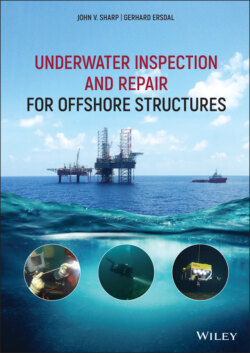Читать книгу Underwater Inspection and Repair for Offshore Structures - Gerhard Ersdal - Страница 31
2.3.3 API RP‐2FSIM (Floating Systems Integrity Management)
ОглавлениеAPI RP‐2FSIM (API 2019a) is a Recommended Practice (RP) intended to be used by owners and engineers in the development, implementation and delivery of a process to maintain system integrity of floating production systems (FPSs), which includes tension leg platforms (TLPs). The specifications, procedures and guidance provided within the RP are based on internationally recognized industry standards and on global industry best practices. This RP does not cover moorings, which are separately covered by API RP‐2MIM (API 2019b).
API RP‐2FSIM (API 2019a) states that an inspection plan should define the scope and frequency of inspection, the tools and techniques to be used and the deployment methods. This plan should be developed for the FPS structural and system components. The main objectives of the inspection plan are to identify areas of corrosion, coating deterioration, damage due to overloading, impact or abrasion, as well as areas affected by marine growth and debris. The plan should also measure or confirm the CP potentials, sensors and alarms, marine system functions and mooring equipment functions. The inspection plan should consist of a set of scheduled work scopes to be performed over the service life of the FPS. In addition, unscheduled surveys should follow an unexpected event such as exposure to a near‐level design event (e.g. hurricane).
API RP‐2FSIM (API 2019a) states that underwater surveys should be performed on the submerged areas of the hull and this should include external marine system components and the mooring system hull attachments. These surveys should also confirm that the corrosion protection system of the external hull is functioning adequately. It is recommended that external hull surveys can be performed on a continuous cycle where a specified percentage of the hull is inspected over a period and at the end of the period all of the hull is covered. A default inspection program for the hull structure is included with calendar‐based intervals and the extent of structure to be inspected by different inspection methods (GVI, CVI, ultrasonic testing and weld inspection).
Monitoring of the structure and marine systems are recommended in API RP‐2FSIM (API 2019a) in addition to inspection. Typical monitoring methods for floating structures are further discussed in Chapter 5.
API RP‐2FSIM (API 2019a) describes an assessment process and acceptance criteria, similar to other relevant API RPs, including the assessment of fatigue damage. The fatigue assessment should assess the fatigue loading behaviour and analyse the remaining fatigue life of critical locations such as welded joints and details in highly stressed areas. If the predicted fatigue life exceeds allowable levels, API RP‐2FSIM (API 2019a) states that improvement options may be considered, including local structural modifications, increased inspection frequency, change of loading conditions and using improved inspection techniques.
Methods for the repair of damage and modifications are described in API RP‐2FSIM (API 2019a), including completely renewing a locally damaged area by means of a structural repair. This may involve the addition of a new structure (e.g. stiffening to reinstate the capacity in a damaged area). Modification of the structural details may be used to minimise the potential for future damage, particularly fatigue (e.g. by grinding).
